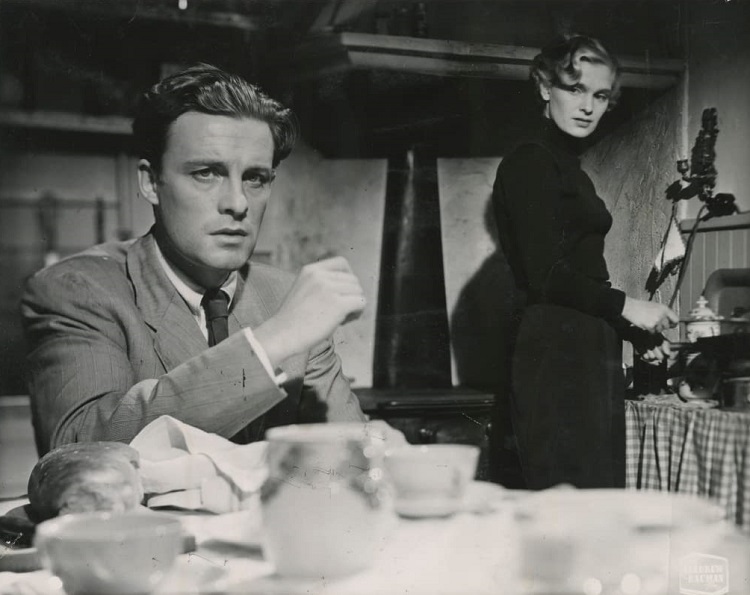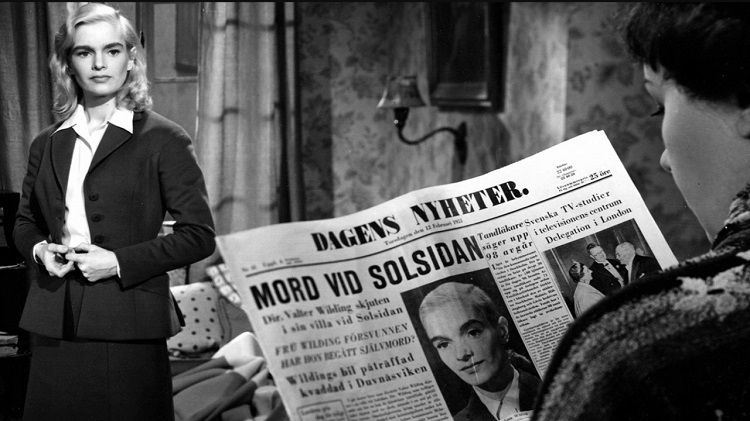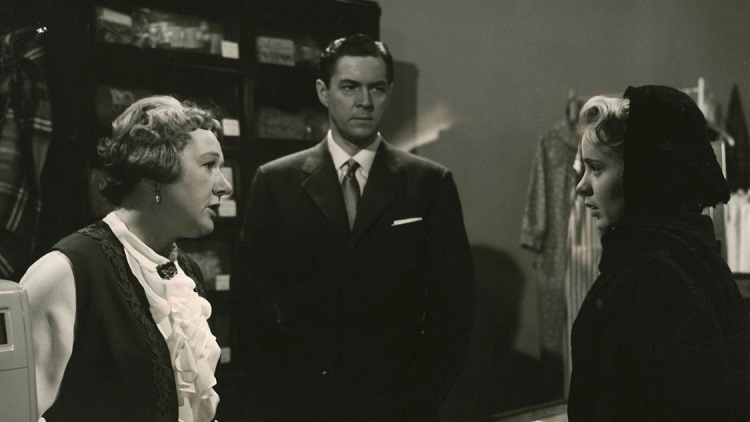Subtext | More Classic Swedish Murder Mysteries
Over the last few years the Swedish Film Institute have blessed us with some amazing restorations of crime films from the 1950s. We previously looked at a collaboration between two giants of Swedish crime writing, as well as the first two films about crime-solving duo the Hillmans. But there are a lot more Swedish mysteries on Netflix, and so we’re going back to the origins of Nordic noir once again.

The White Cat (1950)
A man finds himself on a train arriving at Stockholm. He doesn’t know how he got there, or even his own name. All he has is a keyring with two keys on it, a fancy pen, a piece of paper with an address written on it, and a ten-kroner note that he immediately loses to a pickpocket. In a café he overhears a conversation about an escaped lunatic, and is terrified that might be him. All he remembers is that he can’t go to the police, and something – something terrifying – about a white cat…
Hollywood was always an influence on international cinema, and this film shows the influence of one director in particular: Alfred Hitchcock. Director and co-writer Hasse Ekman was better known for his admiration for Orson Welles, but this film uses Hitchcock’s techniques perfectly to frame a story that could easily have been one of his movies. (The other writer was his frequent collaborator Walter Ljungquist, with the film based on his novel Keys To An Empty Room. This was his only “whodunnit”, inexperience which shows in the clumsy construction of the ending where one character literally just asks another to explain various plot points.) At the time Ekman was Sweden’s most successful director, though nowadays he’s been almost completely eclipsed by a rising star who had barely got started in 1950, Ingmar Bergman. This is often described in retrospect as a “great rivalry”, but in fact the two men worked together often. In fact just the previous year Ekman and his then wife Eva Henning starred in Bergman’s film Three Strange Loves.
Henning played the female lead in several of Ekman’s films during their marriage, including this one where she (as a sympathetic waitress named Auri) tried to help the mysterious man deal with his amnesia. A film like this succeeds or fails based on the central performance, and luckily for Ekman his leading man Alf Kjellin delivers. He gives an “X” who is clearly tormented by uncertainty, but who also manages to show us why Auri trusts him so instinctively. Again, he’s very reminiscent of a Hitchcock leading man. Kjellin had made his Hollywood debut the year before, and he’d split his time between the two countries before settling in California in the 1960s. There he transitioned into being an extremely successful TV director, working on shows like Columbo, The Man From U.N.C.L.E. and, amusingly, The Hitchcock Half-Hour.

In The Mist, aka Lost In The Fog (1953)
Originally released under the title of I dimma dold (“Hidden In Fog”), this film has had two different English titles – neither an actual direct translation. The current title on Netflix is In The Mist, so that’s what we’ll go with. It’s a film with a link to one we’ve looked at before, The Die Is Cast. Vic Suneson (a pen name, his real name was Sune Lundquist) was one of Sweden’s best-known crime writers from 1948 through to his death in 1975. Nowadays he’s not so popular, but at the time he was ranked alongside Maria Lang and Stieg Tranter as a top name. He wrote dozens of novels, but is only credited as the writer on one film: The Die Is Cast. And only one of his novels has been made into a film: I dimma dold.
In The Mist is an interesting film, one that shows how arbitrary genre lines are. It opens with Lora Wilding (Eva Henning, who we just saw as Auri in The White Cat) shooting her husband Walter (Georg Rydeberg) and going on the run. The first half of the film plays out like a classic noir scenario – Eva finding refuge on the shadier side of the city, while the police dragnet slowly begins to close around her. But just under halfway through its 84 minute running time, the film switches gears. With a sudden twist, the story transforms from noir into whodunnit. The mood remains dark, but in some ways it becomes a completely different film. We’re left unsure of ourselves, and the story plays with that uncertainty.
One other interesting aspect of the film is that it’s very firmly set in the post-war period. Sweden was officially neutral during World War 2, though it was effectively under German dominion. The film makes reference to “Peace Day” as a day when the world seemed full of possibilities. This is ironically contrasted by Eva meeting Walter for the first time, setting off a chain of events that would shut down all that freedom. Another character makes reference to Walter having shady dealings with the Nazis during the war, something that would have struck home with its audience. It’s a sobering reminder of how fresh those wounds were, something we also saw in Mannequin In Red with Anita Bjork’s character having lost her family to the Nazi occupation of Paris.

When Darkness Falls (1960)
Speaking of Mannequin In Red, our next film is another from the same director: Arne Mattson. This was not one of his Hillman films but it does star their male lead, Karl-Arne Holmsten, as Inspector Christer Wijk. Wijk gets called out to the small town of Vastlinge when there is a murder on Christmas Eve, though the film does not frame him as the viewpoint character. Our view is through the residents of the local Lutheran vicarage. The priest is Tord Ekstedt, played by Nils Asther. Asther is a fascinating character; a Swede who had some success in Hollywood in the late 1920s and early 1930s. He was homosexual, which at the time was illegal in Sweden. Though it was equally illegal in the USA, it was tolerated and ignored in Hollywood. His initial success ran aground of the vicious studio system, and his career foundered. He returned to Sweden in 1958, fourteen years after homosexuality was legalised there, but he only had four film roles before he retired in 1963. It’s a shame, as he’s clearly a talented actor. Tord is a widower, and the only man in a household of women: his daughter Lotta (Anna-Maria Giertz, a twelve year old in her only film role), his housekeeper Hjördis (Mimi Nelson, who had a small role in In The Mist), and a visiting relative Elisabeth (Birgitta Pettersson, best known for her role as the doomed innocent Karin in Ingmar Bergman’s The Virgin Spring).
The strength of this film lies in its cast, with over a dozen different characters each establishing themselves strongly and distinctly with very little screen time. It’s unsurprising that this was written by another giant of the Swedish mystery writing scene: Maria Lang, often regarded as the first great Swedish crime writer. She wrote forty-two novels, several of which star Inspector Wijk. This film is a very loose adaptation of one of them, Tragedy In A Country Cemetery. Mattson directed the film adaptation of another of them the following year, Lovely Is The Summer Night, starring Karl-Arne Holmsten again. In 2013 these same two novels, along with four other Inspector Wijk stories, were made into direct-to-DVD movies starring Ola Rapace (ex-husband of actress Noomi Rapace) as Wijk. These later adaptations, though more faithful to the novels, lack the charm of Mattson’s adaptations. When Darkness Falls is filled with nice touches, from the recurring adventures of Lotta’s kitten Nefertite to character actor Ake Lindstrom in a scene-stealing cameo as a detective who complains about missing lunch, then is seen in the background eating food taken from the shelves of the grocery store turned crime scene.
There remain many classic Swedish mystery films for us to explore, along with others from further afield in the golden age of movie mysteries. I hope you’ll join us when we return to this fascinating era once more.
Images via IMDB.

